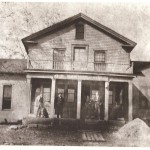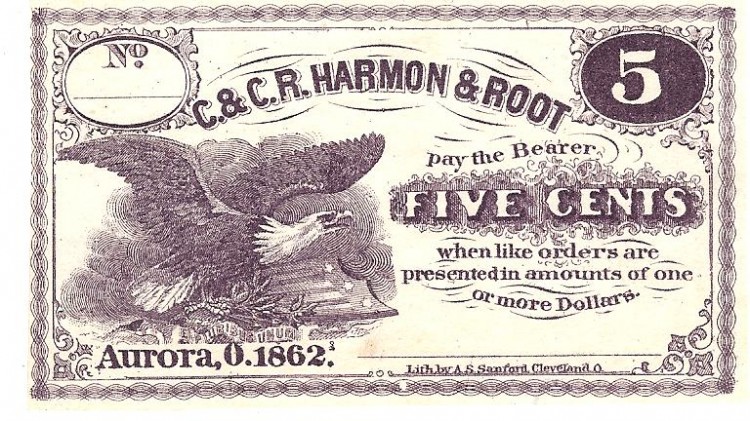C.R. Harmon & Sons Store: An Aurora Institution
 The C.R. Harmon & Sons Store, located at 182 South Chillicothe Road, was an integral part of Aurora. Ebenezer Sheldon II erected the building circa 1838-1840 and it served as his family home. His heirs sold it to the Harmons who converted it into a general store. The store served the community in various ways. First, it was the only general store in the area and provided customers with items they needed such as cloth, foreign and domestic fruit, meat, finished clothing, shoes and boots, and other consumable products. Secondly, it acted as a bank or financial institution. The store accepted I.O.U.s for loaning money to residents as well as sold merchandise on time, meaning that people could pay for their purchases at the end of the month as well as the day they bought items. The store cashed I.O.U.s for others in the area, giving cash to those without it to pay their debts. C.R. Harmon & Sons also collected people’s rents and paid men for worked performed in the community. It also acted as a purchasing agent, buying cheese, meat, fruit, tailored items, and other goods from local residents. During the Civil War era, 1861-1865, the store issued its own scrip as a source of change. Historians call this scrip Fractional Currency and according to Sam Watson, and his internet article entitled A Brief History of US Paper Money (Currency) by Date
The C.R. Harmon & Sons Store, located at 182 South Chillicothe Road, was an integral part of Aurora. Ebenezer Sheldon II erected the building circa 1838-1840 and it served as his family home. His heirs sold it to the Harmons who converted it into a general store. The store served the community in various ways. First, it was the only general store in the area and provided customers with items they needed such as cloth, foreign and domestic fruit, meat, finished clothing, shoes and boots, and other consumable products. Secondly, it acted as a bank or financial institution. The store accepted I.O.U.s for loaning money to residents as well as sold merchandise on time, meaning that people could pay for their purchases at the end of the month as well as the day they bought items. The store cashed I.O.U.s for others in the area, giving cash to those without it to pay their debts. C.R. Harmon & Sons also collected people’s rents and paid men for worked performed in the community. It also acted as a purchasing agent, buying cheese, meat, fruit, tailored items, and other goods from local residents. During the Civil War era, 1861-1865, the store issued its own scrip as a source of change. Historians call this scrip Fractional Currency and according to Sam Watson, and his internet article entitled A Brief History of US Paper Money (Currency) by Date
,
money, especially coinage, became harder and harder to find because people did not trust Confederate or demand notes. People hoarded their coins for the precious gold and silver in it, as well as the other metal in it, such as copper, was instrumental in making war materiel. As a resulting of the hoarding, some businesses started printing their own currency to fill the need for small change. Eventually some shops started using postage stamps to make change for their customers. Following this idea the U.S. Government issued the first Postage currency in 5, 10, 25 and 50 cents denominations. The second issue was started in 1863 and was called Fractional Currency. Fractional currency was printed until 1874 in 3, 5, 10, 15, 25 and 50 cents denominations. At the same time Congress discontinued issuing Demand notes and started issuing Legal Tender Notes (Also known as United States Notes). Legal Tender Notes were the first notes that by law were good for all debts public and private. They were redeemable for silver but redemption was stopped soon after they were first issued (because of the need for the metal to make war materials) but it was resumed in 1879.[1]
Here are examples of Fractional Currency from the C.&C.R. Harmon & Root General Store in Aurora, Ohio. 


 In addition to being instrumental to the daily lives, business, and welfare of the people of Aurora, the store dealt with myriad businesses around the country, connecting the small Village of Aurora to towns and cities hundreds of miles away. The Aurora Historical Society has a vast collection of C.R. Harmon & Sons business letters, documents, daily store ledgers, and correspondence regarding the retail and wholesale transactions from the 1840s – 1930s. The information provides a great deal of information about the buying habits of small town people as well as the vast business contacts of the Harmons. Currently, director of the AHS, Dr. Marcelle Wilson is compiling a list of businesses to help demonstrate the wide association that Aurora had to the rest of the country. In a simple listing, Dr. Wilson discovered that C.R. Harmon & Sons had business relations with over 250 companies and businesses from as close as Mantua, Hudson, and Youngstown to farther away cities as Cleveland, Pittsburgh, and New York. Below is a brief list of the cities, states, and types of businesses that the Harmons dealt with. It shows the types of merchandise that they purchased and provided to their patrons in Aurora from 1881-1900. Dr. Wilson will conduct more research and continue to compile information related to the C.R. Harmon & Sons store so that it can be displayed in the spring and summer of 2011 when the Aurora Historical Society, in conjunction with Dunham Tavern and other North Eastern Ohio museums and historical societies, celebrates the Summer of History, Life in the Western Reserve through the Civil War. This list is a small glimpse of where C.R. Harmon & Sons did business. As further research is done, more information will be revealed. States & Cities Ohio Cleveland, Springfield, Kent, Cincinnati, Norwalk, Grafton, Hudson, Carrollton, Warren, Windham, Ravenna, Elyria, Macedonia, Cuyahoga Falls, Chagrin Falls, Garretsville, Delaware, Salem, Mantua Station, Conneaut, Akron, Youngstown, Canton, Zanesville, Wadsworth, Dayton, Mantua, Burton, Clinton, Sandusky, Berea, Mansfield, Xenia, Newton Falls, Baltimore, Solon, Wellington, Streetsboro, Freedom Pennsylvania Pittsburgh, Philadelphia, Freedom, Huntingdon, Erie, East Brady, Allegheny Maryland Sparrows’ Point,Baltimore Massachusetts Boston New York Weedsport East Buffalo Syracuse Elmira Little Falls Buffalo Cattarugus Rochester Hoosick Falls Fredonia Salamanca Little Valley Michigan Adrian St. Joseph Three Rivers Coldwater Detroit Georgia Kentucky Experiment Newport Connecticut Maine Colchester Waterbury Hallowell Virginia Tennessee Richmond Chattanooga Illinois Wisconsin Chicago Ft. Atkinson Indiana Mishawka South Bend Muncie Kendallville New Jersey Lambertville The products that C.R. Harmon & Sons imported for its general store were numerous. Below is a brief list of the products one might find in the store: Produce, sucker rods, felt, roofing, and roofing paints (roofing supplies), sugar, druggists/chemists, canned goods, dry goods, flour and grain, salt, feed, boots and shoes, confectionery, cigars, tobacco, crackers, oil, hosiery, spinning and knitting works, soap, tea, coffee, and spices, notions, whips, gloves, petroleum products, paint, baskets, etc. C.R. Harmon & Sons had business dealings with companies all over the United States. They imported a vast array of products so that people in Aurora could stock their shelves with items not available locally. Just like the people living in Aurora today have access to items produced in many different locals, so did the people of our community more than 100 years ago.
In addition to being instrumental to the daily lives, business, and welfare of the people of Aurora, the store dealt with myriad businesses around the country, connecting the small Village of Aurora to towns and cities hundreds of miles away. The Aurora Historical Society has a vast collection of C.R. Harmon & Sons business letters, documents, daily store ledgers, and correspondence regarding the retail and wholesale transactions from the 1840s – 1930s. The information provides a great deal of information about the buying habits of small town people as well as the vast business contacts of the Harmons. Currently, director of the AHS, Dr. Marcelle Wilson is compiling a list of businesses to help demonstrate the wide association that Aurora had to the rest of the country. In a simple listing, Dr. Wilson discovered that C.R. Harmon & Sons had business relations with over 250 companies and businesses from as close as Mantua, Hudson, and Youngstown to farther away cities as Cleveland, Pittsburgh, and New York. Below is a brief list of the cities, states, and types of businesses that the Harmons dealt with. It shows the types of merchandise that they purchased and provided to their patrons in Aurora from 1881-1900. Dr. Wilson will conduct more research and continue to compile information related to the C.R. Harmon & Sons store so that it can be displayed in the spring and summer of 2011 when the Aurora Historical Society, in conjunction with Dunham Tavern and other North Eastern Ohio museums and historical societies, celebrates the Summer of History, Life in the Western Reserve through the Civil War. This list is a small glimpse of where C.R. Harmon & Sons did business. As further research is done, more information will be revealed. States & Cities Ohio Cleveland, Springfield, Kent, Cincinnati, Norwalk, Grafton, Hudson, Carrollton, Warren, Windham, Ravenna, Elyria, Macedonia, Cuyahoga Falls, Chagrin Falls, Garretsville, Delaware, Salem, Mantua Station, Conneaut, Akron, Youngstown, Canton, Zanesville, Wadsworth, Dayton, Mantua, Burton, Clinton, Sandusky, Berea, Mansfield, Xenia, Newton Falls, Baltimore, Solon, Wellington, Streetsboro, Freedom Pennsylvania Pittsburgh, Philadelphia, Freedom, Huntingdon, Erie, East Brady, Allegheny Maryland Sparrows’ Point,Baltimore Massachusetts Boston New York Weedsport East Buffalo Syracuse Elmira Little Falls Buffalo Cattarugus Rochester Hoosick Falls Fredonia Salamanca Little Valley Michigan Adrian St. Joseph Three Rivers Coldwater Detroit Georgia Kentucky Experiment Newport Connecticut Maine Colchester Waterbury Hallowell Virginia Tennessee Richmond Chattanooga Illinois Wisconsin Chicago Ft. Atkinson Indiana Mishawka South Bend Muncie Kendallville New Jersey Lambertville The products that C.R. Harmon & Sons imported for its general store were numerous. Below is a brief list of the products one might find in the store: Produce, sucker rods, felt, roofing, and roofing paints (roofing supplies), sugar, druggists/chemists, canned goods, dry goods, flour and grain, salt, feed, boots and shoes, confectionery, cigars, tobacco, crackers, oil, hosiery, spinning and knitting works, soap, tea, coffee, and spices, notions, whips, gloves, petroleum products, paint, baskets, etc. C.R. Harmon & Sons had business dealings with companies all over the United States. They imported a vast array of products so that people in Aurora could stock their shelves with items not available locally. Just like the people living in Aurora today have access to items produced in many different locals, so did the people of our community more than 100 years ago.
[1]Sam Watson, A Brief History of US Paper Money (Currency) by Date, 2003, http://www.jswatson.com/money/History.html, April 26, 2010.
